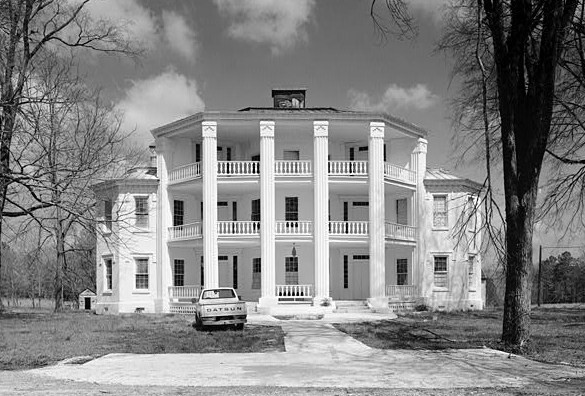
Abbeville Opera House
Abbeville is a city in Abbeville County, South Carolina, United States, 86 miles (138km) west of Columbia. Its population was 5,840 at the 2000 census. It is the county seat of Abbeville County. Settled by French immigrants, it was named along with the county for the French town of the same name.
Abbeville and the American Civil War
The Rock at Secession Hill
Abbeville has the unique distinction of being both the birthplace and the deathbed of the Confederacy. On November 22, 1860, a meeting was held at Abbeville, at a site since dubbed "Secession Hill", to launch South Carolina's secession from the Union; one month later, the state of South Carolina became the first state to secede.
It was also the birthplace of noted states rights advocate John C. Calhoun.
At the end of the Civil War, with the Confederacy in shambles, Confederate President Jefferson Davis fled Richmond, Virginia and headed south, stopping for a night in Abbeville at the home of his friend Armistead Burt. It was on May 2, 1865, in the front parlor of what is now known as the Burt-Stark Mansion that Jefferson Davis officially acknowledged the dissolution of the Confederate government.

Burt-Stark Mansion
Construction
The house is a white Greek Revival style two story house with a frame structure and lap siding. A front pedimented portico, also two stories high, is supported by four square columns. Underneath this is a small wooden latticework second-story balcony. It has a brick foundation, with wooden walls. The roof is made of aluminum and tin, with both asphalt and cedar shingles. The shutters on all the windows are original. There were several exterior buildings, but the only one still standing is the kitchen; the other building once on the property were a carriage house, cow barn, milk house, smokehouse, and well house. Spacious rooms and high ceilings mark the interior. A central great hall with an Adam fanlight is the main entrance to the domicile, with a drawing room on each side. The left drawing room would be where Jefferson Davis would hold his final war council with John C. Breckinridge, his Secretary of War, and senior military officials. Before the War, the wide double doors would open to create a ballroom from the entire front area. The only additions to the house after the War was a bathroom and a northwest corner wing, which provided extra kitchen space. Most of the furnishings are from the 1850's and 1860's.It was built in the 1830s by David Lesley, a local attorney, judge, planter, and Presbyterian Church elder. Lesley had seen a house in the north that he liked, and chose that house as the prototype for his own. He sent a man named Cubic, a slave that was also a master carpenter, to look at the prototype house, and he then oversaw construction of Lesley's.
2003 Right-of-Way Standoff
On December 8, 2003, in a 14-hour standoff that stemmed from a land-survey dispute, two Abbeville lawmen were gunned down by West Abbeville resident Steven Bixby. This siege has been compared by both sympathizers of the Bixbys and law enforcement agents to the events of Waco and Ruby Ridge. In February 2007, Steven Bixby was convicted on 17 counts including the two murders, as well as lesser charges of kidnapping and conspiracy. He was given two death sentences for the murders plus 125 years in prison on the other charges.
Notable residents:
James S. Cothan, (1830-1897), born near Abbeville, United States Congressman from South Carolina
John Henry Logan, (1822-1885), born in Abbeville, physician, served as a surgeon in the Confederate Army during the American Civil War, professor at Atlanta Medical College, and editor of the Atlanta Medical Journal.
Benjamin Glover Shields, (1808-1850), born in Abbeville, was a United States Congressman from Alabama.
John C. Calhoun, 7th American Vice President under Andrew Jackson, notable States Rights Activist, and later the 16th Secretary of State of the United States
Robert Reid Hemphill,(1840-1908), Another important resident of Abbeville was General Robert Reid Hemphill, who fought in the Civil War, and was a member of the House of Representatives from 1876 to 1880 and from 1884 to 1886. He was also a Senator from 1886 to 1894 from Abbeville County, and later Clerk (1894-1908) of the South Carolina Senate. He was also Editor of the "Abbeville Medium". Robert died in Abbeville.
Abbeville In Pictures:

The Young Place

Frazier-Pressley House, Privy, intersection County Roads 33,112 and 47, Abbeville vicinity,

Frazier-Pressley House, Intersection County Roads 33,112 and 47, Abbeville vicinity,

Featherstone Tenant Farm, County Road 81, Lowndesville vicinity,

Abbeville Hydroelectric Power Plant, State Highway 284 and County Road 72, Rocky River (historical),

Long-Hutchison Farm, House, County Road 123, Lowndesville vicinity,

Harper-Featherstone Tenant Farm, County Road 81, Lowndesville vicinity,

Abbeville County Court House

Caldwell-Hutchison Farm, County Road 93, Lowndesville vicinity, Abbeville County, SC

Seaboard Coast Line Railroad Bridge, Spanning Savannah River, Savannah River,

Harbison College Presidents Home
Modern history
In 2011, Abbeville High School won its sixth South Carolina high school football state championship. It was the second title in a row in the 1A division.In 2011, Abbeville High School (South Carolina) also won their 1st South Carolina high school softball championship. It was the first female team to win a state championship in Abbeville High School history. Pitcher Gennifer Durham had a fantastic year, striking out many batters with her ankle-breaking knuckle ball. She currently plays softball for the College of the Holy Cross in Worcester, MA.
Architectural mention
Abbeville is the location of the tallest building in South Carolina, the Prysmian Copper Wire Tower. Built in 2009, the tower is 373 feet (114 m) tall and has 30 floors.Source: Internet


